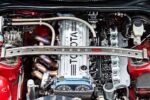Cat 3116 Engine Overview
The Cat 3116 engine, manufactured by Caterpillar Inc., is a well-known diesel engine that has been utilized in various applications, including construction, agriculture, and marine industries. Introduced in the late 1980s, the 3116 was designed to provide reliable power and efficiency in a compact package. With a displacement of 6.6 liters and a power output ranging from 150 to 300 horsepower, it quickly became a popular choice for equipment manufacturers and end-users alike.
Historical Context and Popularity
Caterpillar has a long-standing reputation for producing durable and high-performance engines, and the 3116 is no exception. Its robust design and relatively straightforward maintenance requirements contributed to its widespread adoption. The engine’s versatility allowed it to be installed in various machines, from excavators to generators, making it a staple in many industries.
However, as with any engine, the Cat 3116 is not without its problems. Over the years, users have reported a range of issues that can affect performance, reliability, and overall lifespan. Understanding these problems is crucial for anyone operating equipment powered by the 3116 engine. This article will delve into the common issues associated with the Cat 3116 engine, providing insights into their causes, symptoms, and potential solutions. By addressing these concerns head-on, operators can make informed decisions to ensure the longevity and efficiency of their machinery.
Common Issues with the Cat 3116 Engine
The Cat 3116 engine, while known for its reliability, has its share of problems that can lead to significant operational challenges. Understanding these issues is essential for anyone who relies on this engine for their machinery. Below are some of the most frequently reported problems associated with the Cat 3116 engine.
1. Overheating
Overheating is one of the most common issues faced by Cat 3116 engine users. This problem can arise from several factors, including:
- Insufficient coolant levels
- Faulty thermostat
- Clogged radiator
- Failed water pump
If not addressed promptly, overheating can lead to severe engine damage, including warped cylinder heads and blown gaskets.
2. Fuel System Issues
Fuel system problems can significantly impact the performance of the Cat 3116 engine. Common symptoms include poor fuel economy, rough idling, and difficulty starting. Issues may stem from:
- Clogged fuel filters
- Contaminated fuel
- Faulty injectors
Regular maintenance of the fuel system is crucial to prevent these issues from escalating.
3. Oil Leaks
Oil leaks are another prevalent issue with the Cat 3116 engine. These leaks can occur from various points, such as:
- Valve cover gaskets
- Oil pan seals
- Oil filter
Not only do oil leaks lead to decreased lubrication and increased wear, but they can also pose safety hazards if oil comes into contact with hot engine components.
4. Electrical Problems
Electrical issues can manifest in various ways, including starting problems and erratic performance. Common culprits include:
- Worn-out batteries
- Corroded connections
- Faulty alternators
Proper inspection and maintenance of the electrical system are essential to avoid unexpected breakdowns.
5. Exhaust System Failures
The exhaust system of the Cat 3116 engine can also experience failures, leading to increased emissions and reduced performance. Issues may include:
- Clogged exhaust filters
- Damaged exhaust manifolds
- Leaking exhaust pipes
Addressing exhaust system problems promptly can help maintain engine efficiency and compliance with emissions regulations.
Symptoms and Consequences
Understanding the symptoms associated with these problems can help operators take preventive measures before they escalate into major repairs. Below is a table summarizing the common symptoms and their potential consequences.
| Symptom | Possible Consequence |
|---|---|
| Overheating | Warped cylinder heads, blown gaskets |
| Poor fuel economy | Increased operational costs |
| Rough idling | Engine stalling, reduced performance |
| Oil leaks | Increased wear, safety hazards |
| Starting problems | Unexpected breakdowns, downtime |
| Increased emissions | Non-compliance with regulations |




0 Comments